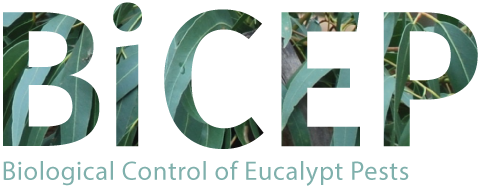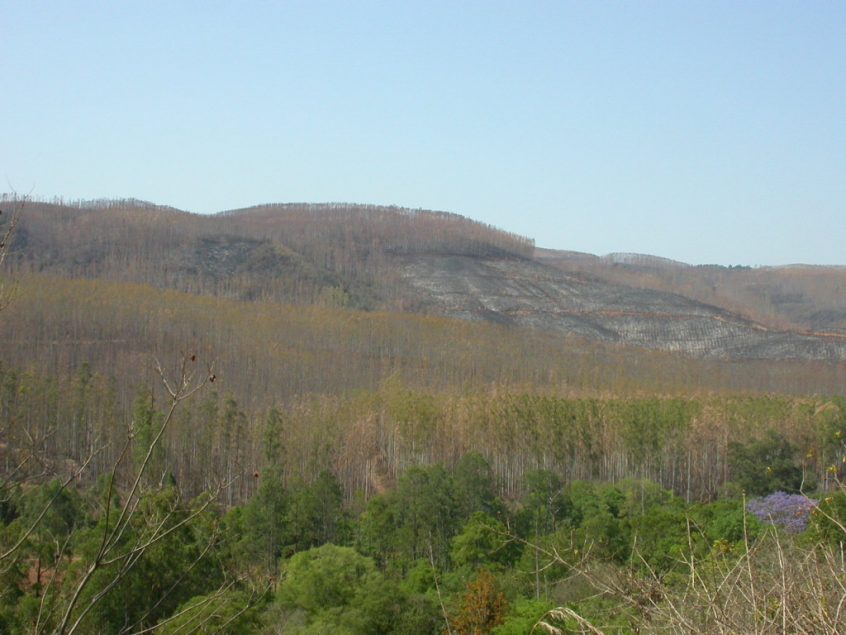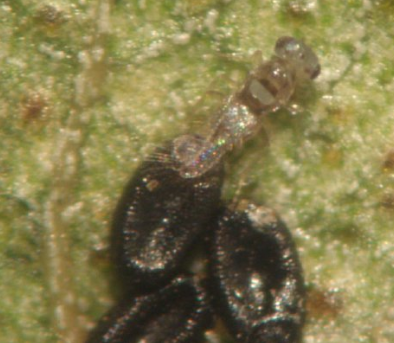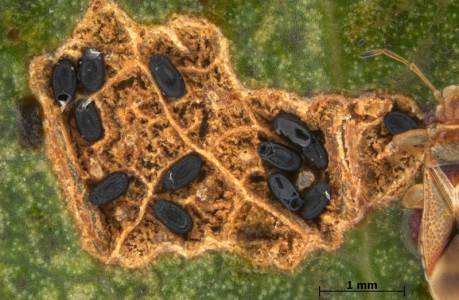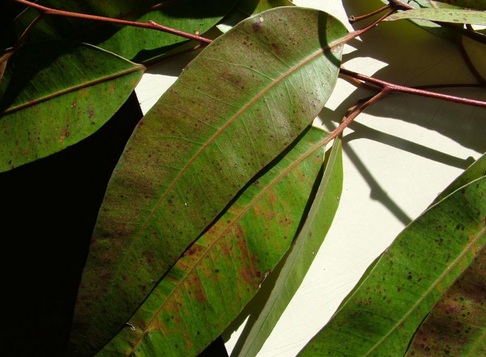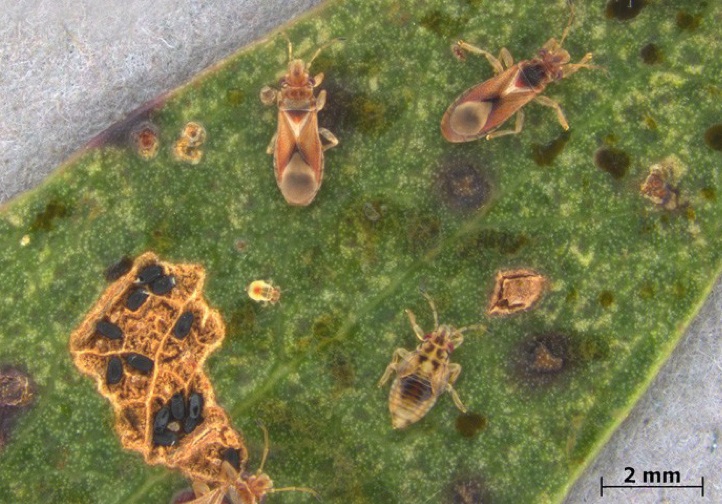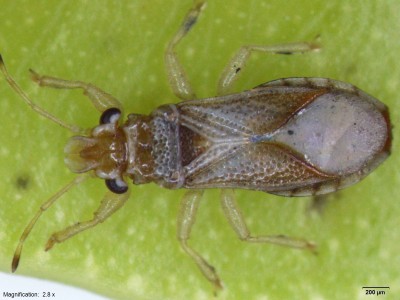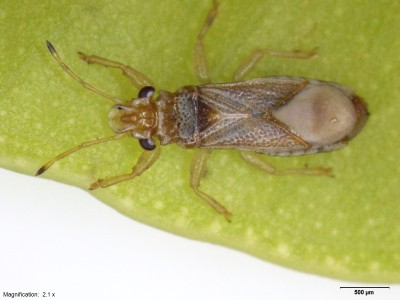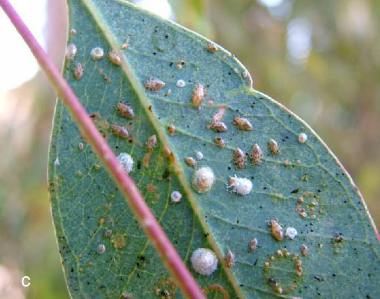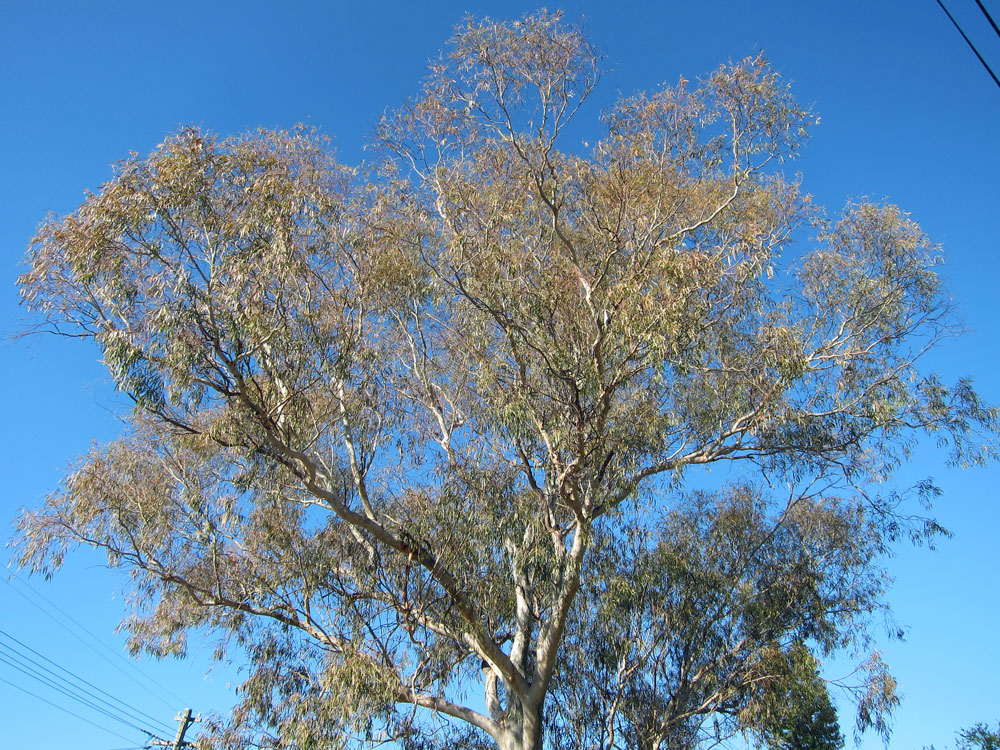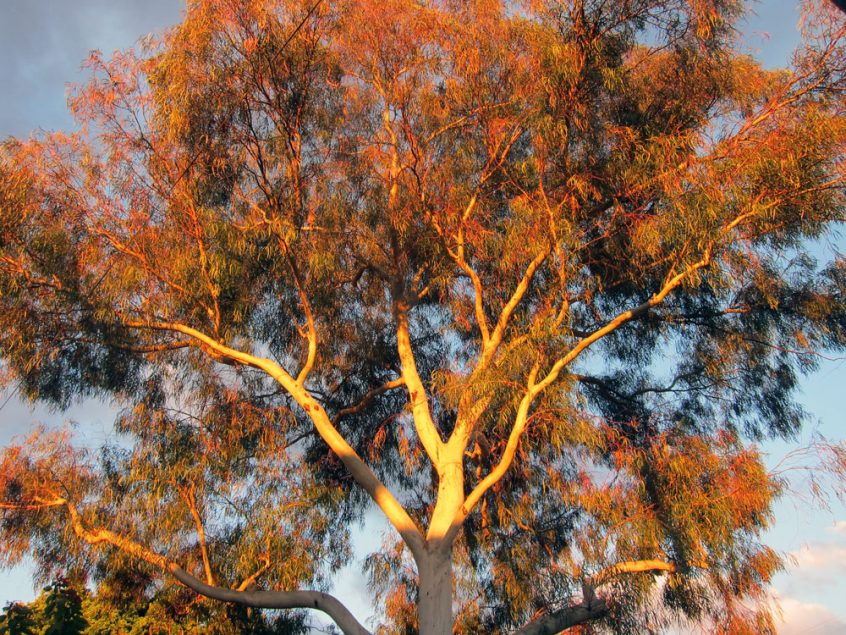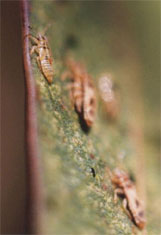Thaumastocoris peregrinus
Thaumastocoris peregrinus
Thaumastocoris peregrinus Carpintero and Dellapé (Hemiptera: Thaumastocoridae) was Today, this Australian endemic insect continues to have a devastating impact on many eucalypt species in the Sydney metropolitan area. As the bronze bug has become an increasingly familiar urban pest in Sydney, it has expanded its range beyond Australia and became a serious international pest. Thaumastocoris peregrinus has spread rapidly across the Southern Hemisphere and tropics, and more recently in southern Europe and the Middle East. It is now causing considerable damage and threatening economic loss, feeding on more than 40 Eucalyptus species and hybrids (see below for full list).
Thaumastocoris peregrinus Carpintero and Dellapé (Hemiptera: Thaumastocoridae) was Today, this Australian endemic insect continues to have a devastating impact on many eucalypt species in the Sydney metropolitan area. As the bronze bug has become an increasingly familiar urban pest in Sydney, it has expanded its range beyond Australia and became a serious international pest. Thaumastocoris peregrinus has spread rapidly across the Southern Hemisphere and tropics, and more recently in southern Europe and the Middle East. It is now causing considerable damage and threatening economic loss, feeding on more than 40 Eucalyptus species and hybrids (see below for full list).
Description
Adults
Thaumastocoris peregrinus is a small (2-3mm) sap-feeding insect in the family Thaumastocoridae (Hemiptera: Heteroptera). The adults are flat bodied and light brown in colour with darker shaded areas.
The nymphal stages
The crawlers and young nymphs are orange in colour, with black spots on the thorax and first abdominal segment. Adults and nymphs are gregarious insects that are often found feeding on the same leaf. The presence of all instars and adults on a leaf is not uncommon.
Eggs
Eggs are laid singly or in black clusters on leaves and stems. They are oval in shape with a sculptured chorion and operculum, with a well defined depression on dorsal side. An average egg size is 0.5 mm long and 0.2 mm wide.
Biology
The lifecycle of T. peregrinus is between 30 – 60 days, consisting of five nymphal instars (16 – 20 days) and an adult phase (14 – 42 days). Females can produce around 60 eggs in this period, which take 4 – 8 days to hatch. As their lifecycle is short, several generations can be produced in a single year. The high reproductive potential of T. peregrinus and short generational time allow for rapid population increases, particularly when optimum conditions for growth and survival are present.
Description
Adults
Thaumastocoris peregrinus is a small (2-3mm) sap-feeding insect in the family Thaumastocoridae (Hemiptera: Heteroptera). The adults are flat bodied and light brown in colour with darker shaded areas.
The nymphal stages
The crawlers and young nymphs are orange in colour, with black spots on the thorax and first abdominal segment. Adults and nymphs are gregarious insects that are often found feeding on the same leaf. The presence of all instars and adults on a leaf is not uncommon.
Eggs
Eggs are laid singly or in black clusters on leaves and stems. They are oval in shape with a sculptured chorion and operculum, with a well defined depression on dorsal side. An average egg size is 0.5 mm long and 0.2 mm wide.
Biology
The lifecycle of T. peregrinus is between 30 – 60 days, consisting of five nymphal instars (16 – 20 days) and an adult phase (14 – 42 days). Females can produce around 60 eggs in this period, which take 4 – 8 days to hatch. As their lifecycle is short, several generations can be produced in a single year. The high reproductive potential of T. peregrinus and short generational time allow for rapid population increases, particularly when optimum conditions for growth and survival are present.
Distribution
Thaumastocoris peregrinus has established itself as a serious pest of Eucalyptus spp. in the Southern Hemisphere. Whilst the exact pathway for introduction across the globe is unclear, T. peregrinus has proven to have a high potential for spread. It’s presence is now confirmed in 15 countries across Australasia, Europe, Southern Africa, South America and the Middle East, where it is considered a major pest on non-native eucalypt species. With the increased movement of plant material globally, it is likely much of the spread has been human mediated through transportation of seedlings and eucalypt products. The potential for natural spread is still unclear.
Distribution
Thaumastocoris peregrinus has established itself as a serious pest of Eucalyptus spp. in the Southern Hemisphere. Whilst the exact pathway for introduction across the globe is unclear, T. peregrinus has proven to have a high potential for spread. It’s presence is now confirmed in 15 countries across Australasia, Europe, Southern Africa, South America and the Middle East, where it is considered a major pest on non-native eucalypt species. With the increased movement of plant material globally, it is likely much of the spread has been human mediated through transportation of seedlings and eucalypt products. The potential for natural spread is still unclear.
Host Trees
In Australia, two eucalypt species, Eucalyptus scoparia Maiden and E. nicholii Maiden and Blakely have been severely infested and impacted. These trees are very common as street, garden and amenity trees, contributing to much of Sydney’s urban forest. Globally, T. peregrinus has now been recorded on more than 40 species of Eucalypt, some Corymbia previously classified as Eucalyptus, and their hybrids. The most susceptible species include Eucalyptus camaldulensis, E. scoparia, E. tereticornis, E. viminalas and any hybrid combinations (see below for full list).
Host Trees
In Australia, two eucalypt species, Eucalyptus scoparia Maiden and E. nicholii Maiden and Blakely have been severely infested and impacted. These trees are very common as street, garden and amenity trees, contributing to much of Sydney’s urban forest. Globally, T. peregrinus has now been recorded on more than 40 species of Eucalypt, some Corymbia previously classified as Eucalyptus, and their hybrids. The most susceptible species include Eucalyptus camaldulensis, E. scoparia, E. tereticornis, E. viminalas and any hybrid combinations (see below for full list).
Damage
These sap-sucking insects feed on Eucalyptus leaves, which results in the leaf turning from a silver spotted hue to a rusty red – brown colour. This symptom, associated with their infestation, is now so widespread it is commonly referred to as “winter bronzing”.
Infested trees initially display a reddening of the leaves and as the infestation progresses, the entire canopy turns reddish yellow. In severe infestations the foliage will wither and drop, leading to branch dieback and in some cases tree death. Feeding also leads to loss of leaf surface, reduced photosynthesis and stunting of growth.
Damage
These sap-sucking insects feed on Eucalyptus leaves, which results in the leaf turning from a silver spotted hue to a rusty red – brown colour. This symptom, associated with their infestation, is now so widespread it is commonly referred to as “winter bronzing”.
Infested trees initially display a reddening of the leaves and as the infestation progresses, the entire canopy turns reddish yellow. In severe infestations the foliage will wither and drop, leading to branch dieback and in some cases tree death. Feeding also leads to loss of leaf surface, reduced photosynthesis and stunting of growth.
Monitoring Impact
Prior to the infestations in Sydney in 2002, little research had been conducted on any species of Thaumastocoris. Since then, the distribution of T. peregrinus has been monitored, documenting the movement and establishment of new outbreaks across the globe. Studies looking at the development biology of this pest are taking place (Soliman et al. 2012, Nadel et al. 2014, Noack & Rose 2007). How this information translates across different climates and hosts is still not fully understood, particularly the factors that influence the population dynamics of T. peregrinus. As the speed of invasion is so high, understanding the drivers of movement are critical for developing climate matched prediction models and identifying areas at risk of invasion. This information is also essential for developing future management programs.
Monitoring Impact
Prior to the infestations in Sydney in 2002, little research had been conducted on any species of Thaumastocoris. Since then, the distribution of T. peregrinus has been monitored, documenting the movement and establishment of new outbreaks across the globe. Studies looking at the development biology of this pest are taking place (Soliman et al. 2012, Nadel et al. 2014, Noack & Rose 2007). How this information translates across different climates and hosts is still not fully understood, particularly the factors that influence the population dynamics of T. peregrinus. As the speed of invasion is so high, understanding the drivers of movement are critical for developing climate matched prediction models and identifying areas at risk of invasion. This information is also essential for developing future management programs.
Control
Chemical control
In Australia the chemical control option for T. peregrinus is Imidacloprid. In urban settings, systemic injection of Imidacloprid into tree trunks provides effective control. In young trees this is an effective option as the chemical disperses evenly throughout the growing plant, making it particularly effective against sucking pests. In an urban setting, such as the Sydney locations of the 2002 outbreak, systemic use of Imidacloprid on target trees was effective. It was also desirable in its application as it reduced the possibility of drift in densely populated areas. On a commercial production scale this method is not economical, being both time consuming and costly. In addition, aerial spraying is ineffective because the highest densities of bugs occur in the mid-canopy which cannot be targeted by aerials sprays. In other areas of the word there are no registered chemical options against T. peregrinus. And in some countries, such as Brazil, the use of chemical controls in commercial plantations is restricted on an environmental basis. This highlights the need for further research into alternate modes of control – cultural, biological and chemical.
Host resistance
Host resistance is not a viable option at present. Thaumastocoris peregrinus has shown no clear patterns of resistance attacking a wide variety of Eucalyptus species, including hybrid species.
Biological control
Currently, the most effective control option against T. peregrinus is the use of biological control agent Cleruchoides noackae Lin and Huber (Hymenoptera: Mymaridae). This minute mymarid wasp is a solitary endoparasitoid of T. peregrinus eggs. It was recovered in 2002 from T. peregrinus eggs in Sydney, Australia, where it is thought to be a relatively common egg parasitoid. Host specificity testing established that C. noackae is capable of attacking other species in the Thaumastocoridae family, but it has shown no signs of attacking hosts outside of this subfamily. It has now been released as a biological control agent of T. peregrinus in Chile, Brazil and South Africa.
The first release of C. noackae as a biological control agent took place in Chile. A total of 230 adults and 3,937 parasitised eggs were imported from Australia, reared in quarantine and released into the field in 2009. Release of C. noackae in Brazil occurred in the state of Minas Gerais, where the incidence of T. peregrinus in Eucalyptus plantations is high (further information in Portuguese and English at the IPEF website). South Africa imported C. noackaefrom Australia into the Forestry and Agriculture Biotechnology Institute (FABI), University of Pretoria, in 2008. Field release took place in Limpopo in 2013, around the Tzaneen area, and the KwaZulu-Natal midlands around Pietermaritzburg and Richmond. Field parasitism rates have been promising and the wasp has now been released in Argentina.
General natural enemies have been observed attacking or infecting T. peregrinus such as the Green Lacewing Chyrsoperla extena Hagen (Neuroptera: Chyrsopidae), Atopozelus opsimus Elkin (Hemiptera: Reuviidae) and entomopthanogenic fungi Beauveria bassiana (Balsamo) Veillemin and Zoophtara radicans (Brefeld) Batko (Entomophtharales: Entomophthoraceace). Another egg parasitoid Stenthynium sp. (Hymenoptera: Mymaridae) has also been confirmed attacking T. peregrinus eggs in Australia, but at very low densities.
Control
Chemical control
In Australia the chemical control option for T. peregrinus is Imidacloprid. In urban settings, systemic injection of Imidacloprid into tree trunks provides effective control. In young trees this is an effective option as the chemical disperses evenly throughout the growing plant, making it particularly effective against sucking pests. In an urban setting, such as the Sydney locations of the 2002 outbreak, systemic use of Imidacloprid on target trees was effective. It was also desirable in its application as it reduced the possibility of drift in densely populated areas. On a commercial production scale this method is not economical, being both time consuming and costly. In addition, aerial spraying is ineffective because the highest densities of bugs occur in the mid-canopy which cannot be targeted by aerials sprays. In other areas of the word there are no registered chemical options against T. peregrinus. And in some countries, such as Brazil, the use of chemical controls in commercial plantations is restricted on an environmental basis. This highlights the need for further research into alternate modes of control – cultural, biological and chemical.
Host resistance
Host resistance is not a viable option at present. Thaumastocoris peregrinus has shown no clear patterns of resistance attacking a wide variety of Eucalyptus species, including hybrid species.
Biological control
Currently, the most effective control option against T. peregrinus is the use of biological control agent Cleruchoides noackae Lin and Huber (Hymenoptera: Mymaridae). This minute mymarid wasp is a solitary endoparasitoid of T. peregrinus eggs. It was recovered in 2002 from T. peregrinus eggs in Sydney, Australia, where it is thought to be a relatively common egg parasitoid. Host specificity testing established that C. noackae is capable of attacking other species in the Thaumastocoridae family, but it has shown no signs of attacking hosts outside of this subfamily. It has now been released as a biological control agent of T. peregrinus in Chile, Brazil and South Africa.
The first release of C. noackae as a biological control agent took place in Chile. A total of 230 adults and 3,937 parasitised eggs were imported from Australia, reared in quarantine and released into the field in 2009. Release of C. noackae in Brazil occurred in the state of Minas Gerais, where the incidence of T. peregrinus in Eucalyptus plantations is high (further information in Portuguese and English at the IPEF website). South Africa imported C. noackaefrom Australia into the Forestry and Agriculture Biotechnology Institute (FABI), University of Pretoria, in 2008. Field release took place in Limpopo in 2013, around the Tzaneen area, and the KwaZulu-Natal midlands around Pietermaritzburg and Richmond. Field parasitism rates have been promising and the wasp has now been released in Argentina.
General natural enemies have been observed attacking or infecting T. peregrinus such as the Green Lacewing Chyrsoperla extena Hagen (Neuroptera: Chyrsopidae), Atopozelus opsimus Elkin (Hemiptera: Reuviidae) and entomopthanogenic fungi Beauveria bassiana (Balsamo) Veillemin and Zoophtara radicans (Brefeld) Batko (Entomophtharales: Entomophthoraceace). Another egg parasitoid Stenthynium sp. (Hymenoptera: Mymaridae) has also been confirmed attacking T. peregrinus eggs in Australia, but at very low densities.
Host Species
Eucalyptus trees from which Gonipterus spp. have been recorded:
- Corymbia citriodora
- C. henryi
- C. maculate
- E. agrophloia
- E. benthamii
- E. bicostata
- E. botryoides
- E. bridgesiana
- E. camaldulensis*
- E. cypellocarpa
- E. dorrigoensis
- E. dunnii
- E. globulus
- E. gomphocephola
- E. grandis
- E. largiflorens
- E. macarthurii
- E. maidenii
- E. microcorys
- E. nicholii
- E. nitens
- E. occidentalis
- E. ovata
- E. paniculata
- E. pauciflora
- E. pilularis
- E. pulverulenta
- E. punctate
- E. resinifera
- E. rudis
- E. robusta
- E. saligna
- E. scoparia*
- E. sideroxylan
- E. smithii
- E. tereticornis*
- E. urophylla
- E. viminalas*
- E. camaldulensis x E. biscostata
- E. grandis x E. camaldulensis
- E. grandis x E. nitens
- E. grandis x E. urophylla
*Highly susceptible to T. peregrinus
Host Species
Eucalyptus trees from which Gonipterus spp. have been recorded:
- Corymbia citriodora
- C. henryi
- C. maculate
- E. agrophloia
- E. benthamii
- E. bicostata
- E. botryoides
- E. bridgesiana
- E. camaldulensis*
- E. cypellocarpa
- E. dorrigoensis
- E. dunnii
- E. globulus
- E. gomphocephola
- E. grandis
- E. largiflorens
- E. macarthurii
- E. maidenii
- E. microcorys
- E. nicholii
- E. nitens
- E. occidentalis
- E. ovata
- E. paniculata
- E. pauciflora
- E. pilularis
- E. pulverulenta
- E. punctate
- E. resinifera
- E. rudis
- E. robusta
- E. saligna
- E. scoparia*
- E. sideroxylan
- E. smithii
- E. tereticornis*
- E. urophylla
- E. viminalas*
- E. camaldulensis x E. biscostata
- E. grandis x E. camaldulensis
- E. grandis x E. nitens
- E. grandis x E. urophylla
*Highly susceptible to T. peregrinus
Andris, M, Aradottir, GI, Arnau, G, et al. 2010, Permanent Genetic Resources added to Molecular Ecology Resources Database 1 June 2010-31 July 2010. Molecular Ecology Resources 10, 1106-1108.
Benitez Diaz, EA, Sosa Coronel, R & Godziewski, D 2013,’Consideraciones sobre dos nuevas plagas del eucalipto en Paraguay el psilidao de la concha o escudo Glycaspsi brimblecombei (Hemiptera: Psyllidae) y la chinche marron Thaumastocoris peregrinus(Hemiptera: Thaumastocoridae)’, Boletin del Museo Nacional de Historia Natural de Paraguay, vol. 17, 72-75.
Carpintero, DL & Dellapé, PM 2006,’ A new species of Thaumastocoris Kirkaldy from Argentina (Heteroptera: Thaumastocoridae: Thaumastocorinae)’, Zootaxa, 61-68.
Chiaradia, LA & Bearzi, RC 2010,’ Characterization and damages of the eucalyptus tan bug’, Agropecuaria Catarinense vol. 23, 89-91.
Dias, TKR, Wilcken, CF, Soliman, EP, Barbosa, LR, Serrão, JR & Zanuncio, JC 2014,’ Predation of Thaumastocoris peregrinus (Hemiptera: Thaumastocoridae) by Atopozelusopsimus (Hemiptera: Reduviidae) in Brazil,’ Invertebrate Survival Journal, vol. 11, 224-227.
Forestry Commission 2014, Forestry invasive alien insect pests in Zimbabwe, www.forestry.co.zw
Garcia, A, Figueiredo, E, Valente, C, Monserrat, VJ & Branco, M 2013,’ First record of Thaumastocoris peregrinus in Portugal and of the neotropical predator Hemerobius bolivari in Europe,’ Bulletin of Insectology, vol. 66 (2), 251-256
González, A, Calvo, MV, Cal, V, Hernández, V, Doño, F, Alves, L, Gamenara, D, Rossini, C & Martinez, G 2012,’ A male aggregation pheromone in the bronze bug, Thaumastocoris peregrinus (Thaumastocoridae)’, Psyche 2012:7.
Gray, KA, Noack, A, Johnson, RN, et al. 2010,’ Eleven di-nucleotide polymorphic microsatellite markers for the winter bronzing bug Thaumastocoris peregrinus Carpintero and Dellapé (Heteroptera: Thaumastocoridae)’, Molecular Ecology Resources 10, 1106-1108.
Ide, SM, Ruiz, CG, Sandoval, AC & Valenzuela, JE 2011,’ Detection of Thaumastocoris peregrinus (Hemiptera: Thaumastocoridae) associated to Eucalyptus spp. in Chile’, Bosque, vol. 32, 309-313.
Jacobs, DH & Neser, S 2005,’ Thaumastocoris australicus Kirkaldy (Heteroptera: Thaumastocoridae): A new insect arrival in South Africa, damaging to Eucalyptus trees’, South African Journal of Science, vol. 101, 233-236.
Laudonia, S & Sasso, R 2012,’ The bronze bug Thaumastocoris peregrinus: a new insect recorded in Italy, damaging to Eucalyptus trees’, Bulletin of Insectology, vol. 65, 89-93.
Lawson, SA, McDonald, JM & Pegg, GS 2008,’ Forest health surveillance methodology in hardwood plantations in Queensland, Australia’, Australian Forestry, vol. 71, 177-181.
Martinez, G & Bianchi, M (2010). First record in Uruguay of the bronze bug, Thaumastocoris peregrinus Carpintero and Dellappé, 2006 (Heteroptera: Thaumastocoridae). Agrociencia, vol. 14, 15-18.
Martins, CB, Soldi, RA, Barbosa, LR, Aldrich, JR & Zarbin, PH (2012). Volatile chemicals of adults and nymphs of the Eucalyptus pest, Thaumastocoris peregrinus (Heteroptera: Thaumastocoridae). Psyche 2012:6.
Martins, CBC & Zarbin, PHG 2013,’ Volatile organic compounds of conspecific-damaged Eucalyptus benthamii influence responses of mated females of Thaumastocoris peregrinus’,Journal of Chemical Ecology, vol. 39, 602-611.
Mascarin, GM, Duarte, VdS, Brandao, MM & Delalibera, IJr 2012,’ Natural occurrence of Zoophthora radicans (Entomophthorales: Entomophthoraceae) on Thaumastocoris peregrinus(Heteroptera: Thaumastocoridae), an invasive pest recently found in Brazil’, Journal of invertebrate pathology, vol.110, 401-404.
Mutitu, EK, Garnas, JR, Hurley, BP, Wingfield, MJ, Harney, M, Bush, SJ & Slippers, B 2013,’ Biology and rearing of Cleruchoides noackae (Hymenoptera: Mymaridae), an egg parasitoid for the biological control of Thaumastocoris peregrinus (Hemiptera: Thaumastocoridae)’, Journal of Economic Entomology, vol. 106, 1979-1985.
Nadel, RL, Slippers, B, Scholes, MC, Lawson, SA, Noack, AE, Wilcken, CF, Bouve,l JP & Wingfield, MJ 2010,’ DNA bar-coding reveals source and patterns of Thaumastocoris peregrinus invasions in South Africa and South America’, Biological Invasions, vol. 12, 1067-1077.
Nadel, RL, Wingfield, MJ, Scholes, MC, Lawson, SA, Noack, AE & Neser, S 2012,’ Mitochondrial DNA diversity of Cleruchoides noackae (Hymenoptera: Mymaridae): a potential biological control agent for Thaumastocoris peregrinus (Hemiptera: Thaumastocoridae)’, Biocontrol, vol. 57, 397-404.
Nadel, RL, Wingfield, MJ, Scholes, MC, Garnas, JR, Lawson, SA, Slippers, B 2015,’ Population dynamics of Thaumastocoris peregrinus in Eucalyptus plantations in South Africa’, Journal of Pest Science, vol. 88, 97-106.
New Zealand Farm Forestry Association 2012, Pests and diseases of forestry in New Zealand, Bronze bug, Thaumastocoris peregrinus: A new eucalyptus pest in New Zealand, www.nzffa.org.nz
Noack, AE & Coviella, CE 2006,’ Thaumastocoris australicus Kirkaldy (Hemiptera: Thaumastocoridae): first record of this invasive pest of Eucalyptus in the Americas’, General and Applied Entomology, vol. 35, 13-14.
Noack, AE & Rose, HA 2007,’ Life-history of Thaumastocoris peregrinus and Thaumastocorissp. in the laboratory with some observations on behaviour’, General and Applied Entomology, vol. 36, 27-33. Full Text : PDF
Noack, AE, Kaapro, J, Bartimote-Aufflick, K, Mansfield, S & Rose, HA 2009,’ Efficacy of imidacloprid in the control of Thaumastocoris peregrinus on Eucalyptus scoparia in Sydney, Australia’, Arboriculture & Urban Forestry, vol. 35, 192-196.
Noack, AE, Cassis, G & Rose, HA 2011,’ Systematic revision of Thaumastocoris Kirkaldy (Hemiptera: Heteroptera: Thaumastocoridae)’, Zootaxa, 3121: 1–60 (Abstract).
Oumar, Z & Mutanga, O 2011,’ The potential of remote sensing technology for the detection and mapping of Thaumastocoris peregrinus in plantation forests’, Southern Forests, vol. 73, 23-31.
Ouma,r Z, Mutanga, O & Ismail, R 2013,’ Predicting Thaumastocoris peregrinus damage using narrow band normalized indices and hyperspectral indices using field spectra resampled to the Hyperion sensor’, International Journal of Applied Earth Observation and Geoinformation, vol. 21, 113-121.
Pereira, JM, de Melo, APC, Fernandes, PM & Soliman, EP 2013,’ Occurence of the Thaumastocoris peregrinus Carpintero & Dellapé (Hemiptera: Thaumastocoridae) in Goias State’, Ciencia Rural, vol. 43, 254-257
Sasso, R 2012, Thaumastocoris peregrinus (Hemiptera: Thaumastocoridae), Bronze Bug, European and Mediterranean Plant Protection Organisation, www.eppo.int
Savaris, M, Lampert, S, Valle da Silva Pereira, PR & Salvadori, J 2011,’ First record of Thaumastocoris peregrinus for the state of Santa Catarina, and new areas of occurrence for the Rio Grande do Sul, Brazil’, Ciencia Rural, vol. 41, 1874-1876.
Soliman, EP, Wilcken, CF, Pereira, JM, Dias, TKR, Zaché, B, Dal Pogetto, MHFA & Barbosa, LR 2012,’ Biology of Thaumastocoris peregrinus in different eucalyptus species and hybrids’, Phytoparasitica, vol. 40, 223-230.
Sopow, S, George, S & Ward, N 2012,’ Bronze bug, Thaumastocoris peregrinus: a new Eucalyptus pest in New Zealand’, Surveillance, vol. 39 (2), 43-46.
Wilcken, CF, Soliman, EP, Nogueira de Sá, LA, Barbosa, LR, Dias, TKR, Ferreira-Filho, PJ, Oliveir, RJR 2010,’ Bronze bug Thaumastocoris peregrinus Carpintero and Dellapé (Hemiptera: Thaumastocoridae) on Eucalyptus in Brazil and its distribution’, Journal of Plant Protection Research, vol. 50 (2), 201-205
Andris, M, Aradottir, GI, Arnau, G, et al. 2010, Permanent Genetic Resources added to Molecular Ecology Resources Database 1 June 2010-31 July 2010. Molecular Ecology Resources 10, 1106-1108.
Benitez Diaz, EA, Sosa Coronel, R & Godziewski, D 2013,’Consideraciones sobre dos nuevas plagas del eucalipto en Paraguay el psilidao de la concha o escudo Glycaspsi brimblecombei (Hemiptera: Psyllidae) y la chinche marron Thaumastocoris peregrinus(Hemiptera: Thaumastocoridae)’, Boletin del Museo Nacional de Historia Natural de Paraguay, vol. 17, 72-75.
Carpintero, DL & Dellapé, PM 2006,’ A new species of Thaumastocoris Kirkaldy from Argentina (Heteroptera: Thaumastocoridae: Thaumastocorinae)’, Zootaxa, 61-68.
Chiaradia, LA & Bearzi, RC 2010,’ Characterization and damages of the eucalyptus tan bug’, Agropecuaria Catarinense vol. 23, 89-91.
Dias, TKR, Wilcken, CF, Soliman, EP, Barbosa, LR, Serrão, JR & Zanuncio, JC 2014,’ Predation of Thaumastocoris peregrinus (Hemiptera: Thaumastocoridae) by Atopozelusopsimus (Hemiptera: Reduviidae) in Brazil,’ Invertebrate Survival Journal, vol. 11, 224-227.
Forestry Commission 2014, Forestry invasive alien insect pests in Zimbabwe, www.forestry.co.zw
Garcia, A, Figueiredo, E, Valente, C, Monserrat, VJ & Branco, M 2013,’ First record of Thaumastocoris peregrinus in Portugal and of the neotropical predator Hemerobius bolivari in Europe,’ Bulletin of Insectology, vol. 66 (2), 251-256
González, A, Calvo, MV, Cal, V, Hernández, V, Doño, F, Alves, L, Gamenara, D, Rossini, C & Martinez, G 2012,’ A male aggregation pheromone in the bronze bug, Thaumastocoris peregrinus (Thaumastocoridae)’, Psyche 2012:7.
Gray, KA, Noack, A, Johnson, RN, et al. 2010,’ Eleven di-nucleotide polymorphic microsatellite markers for the winter bronzing bug Thaumastocoris peregrinus Carpintero and Dellapé (Heteroptera: Thaumastocoridae)’, Molecular Ecology Resources 10, 1106-1108.
Ide, SM, Ruiz, CG, Sandoval, AC & Valenzuela, JE 2011,’ Detection of Thaumastocoris peregrinus (Hemiptera: Thaumastocoridae) associated to Eucalyptus spp. in Chile’, Bosque, vol. 32, 309-313.
Jacobs, DH & Neser, S 2005,’ Thaumastocoris australicus Kirkaldy (Heteroptera: Thaumastocoridae): A new insect arrival in South Africa, damaging to Eucalyptus trees’, South African Journal of Science, vol. 101, 233-236.
Laudonia, S & Sasso, R 2012,’ The bronze bug Thaumastocoris peregrinus: a new insect recorded in Italy, damaging to Eucalyptus trees’, Bulletin of Insectology, vol. 65, 89-93.
Lawson, SA, McDonald, JM & Pegg, GS 2008,’ Forest health surveillance methodology in hardwood plantations in Queensland, Australia’, Australian Forestry, vol. 71, 177-181.
Martinez, G & Bianchi, M (2010). First record in Uruguay of the bronze bug, Thaumastocoris peregrinus Carpintero and Dellappé, 2006 (Heteroptera: Thaumastocoridae). Agrociencia, vol. 14, 15-18.
Martins, CB, Soldi, RA, Barbosa, LR, Aldrich, JR & Zarbin, PH (2012). Volatile chemicals of adults and nymphs of the Eucalyptus pest, Thaumastocoris peregrinus (Heteroptera: Thaumastocoridae). Psyche 2012:6.
Martins, CBC & Zarbin, PHG 2013,’ Volatile organic compounds of conspecific-damaged Eucalyptus benthamii influence responses of mated females of Thaumastocoris peregrinus’,Journal of Chemical Ecology, vol. 39, 602-611.
Mascarin, GM, Duarte, VdS, Brandao, MM & Delalibera, IJr 2012,’ Natural occurrence of Zoophthora radicans (Entomophthorales: Entomophthoraceae) on Thaumastocoris peregrinus(Heteroptera: Thaumastocoridae), an invasive pest recently found in Brazil’, Journal of invertebrate pathology, vol.110, 401-404.
Mutitu, EK, Garnas, JR, Hurley, BP, Wingfield, MJ, Harney, M, Bush, SJ & Slippers, B 2013,’ Biology and rearing of Cleruchoides noackae (Hymenoptera: Mymaridae), an egg parasitoid for the biological control of Thaumastocoris peregrinus (Hemiptera: Thaumastocoridae)’, Journal of Economic Entomology, vol. 106, 1979-1985.
Nadel, RL, Slippers, B, Scholes, MC, Lawson, SA, Noack, AE, Wilcken, CF, Bouve,l JP & Wingfield, MJ 2010,’ DNA bar-coding reveals source and patterns of Thaumastocoris peregrinus invasions in South Africa and South America’, Biological Invasions, vol. 12, 1067-1077.
Nadel, RL, Wingfield, MJ, Scholes, MC, Lawson, SA, Noack, AE & Neser, S 2012,’ Mitochondrial DNA diversity of Cleruchoides noackae (Hymenoptera: Mymaridae): a potential biological control agent for Thaumastocoris peregrinus (Hemiptera: Thaumastocoridae)’, Biocontrol, vol. 57, 397-404.
Nadel, RL, Wingfield, MJ, Scholes, MC, Garnas, JR, Lawson, SA, Slippers, B 2015,’ Population dynamics of Thaumastocoris peregrinus in Eucalyptus plantations in South Africa’, Journal of Pest Science, vol. 88, 97-106.
New Zealand Farm Forestry Association 2012, Pests and diseases of forestry in New Zealand, Bronze bug, Thaumastocoris peregrinus: A new eucalyptus pest in New Zealand, www.nzffa.org.nz
Noack, AE & Coviella, CE 2006,’ Thaumastocoris australicus Kirkaldy (Hemiptera: Thaumastocoridae): first record of this invasive pest of Eucalyptus in the Americas’, General and Applied Entomology, vol. 35, 13-14.
Noack, AE & Rose, HA 2007,’ Life-history of Thaumastocoris peregrinus and Thaumastocorissp. in the laboratory with some observations on behaviour’, General and Applied Entomology, vol. 36, 27-33. Full Text : PDF
Noack, AE, Kaapro, J, Bartimote-Aufflick, K, Mansfield, S & Rose, HA 2009,’ Efficacy of imidacloprid in the control of Thaumastocoris peregrinus on Eucalyptus scoparia in Sydney, Australia’, Arboriculture & Urban Forestry, vol. 35, 192-196.
Noack, AE, Cassis, G & Rose, HA 2011,’ Systematic revision of Thaumastocoris Kirkaldy (Hemiptera: Heteroptera: Thaumastocoridae)’, Zootaxa, 3121: 1–60 (Abstract).
Oumar, Z & Mutanga, O 2011,’ The potential of remote sensing technology for the detection and mapping of Thaumastocoris peregrinus in plantation forests’, Southern Forests, vol. 73, 23-31.
Ouma,r Z, Mutanga, O & Ismail, R 2013,’ Predicting Thaumastocoris peregrinus damage using narrow band normalized indices and hyperspectral indices using field spectra resampled to the Hyperion sensor’, International Journal of Applied Earth Observation and Geoinformation, vol. 21, 113-121.
Pereira, JM, de Melo, APC, Fernandes, PM & Soliman, EP 2013,’ Occurence of the Thaumastocoris peregrinus Carpintero & Dellapé (Hemiptera: Thaumastocoridae) in Goias State’, Ciencia Rural, vol. 43, 254-257
Sasso, R 2012, Thaumastocoris peregrinus (Hemiptera: Thaumastocoridae), Bronze Bug, European and Mediterranean Plant Protection Organisation, www.eppo.int
Savaris, M, Lampert, S, Valle da Silva Pereira, PR & Salvadori, J 2011,’ First record of Thaumastocoris peregrinus for the state of Santa Catarina, and new areas of occurrence for the Rio Grande do Sul, Brazil’, Ciencia Rural, vol. 41, 1874-1876.
Soliman, EP, Wilcken, CF, Pereira, JM, Dias, TKR, Zaché, B, Dal Pogetto, MHFA & Barbosa, LR 2012,’ Biology of Thaumastocoris peregrinus in different eucalyptus species and hybrids’, Phytoparasitica, vol. 40, 223-230.
Sopow, S, George, S & Ward, N 2012,’ Bronze bug, Thaumastocoris peregrinus: a new Eucalyptus pest in New Zealand’, Surveillance, vol. 39 (2), 43-46.
Wilcken, CF, Soliman, EP, Nogueira de Sá, LA, Barbosa, LR, Dias, TKR, Ferreira-Filho, PJ, Oliveir, RJR 2010,’ Bronze bug Thaumastocoris peregrinus Carpintero and Dellapé (Hemiptera: Thaumastocoridae) on Eucalyptus in Brazil and its distribution’, Journal of Plant Protection Research, vol. 50 (2), 201-205
